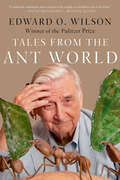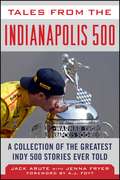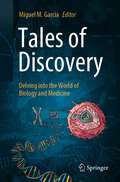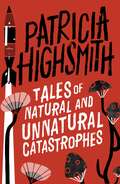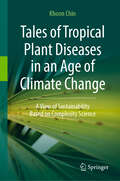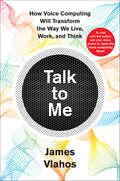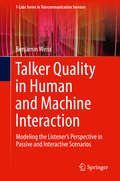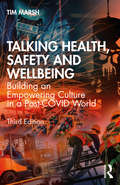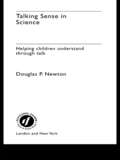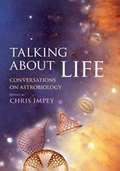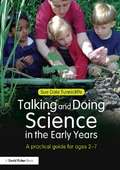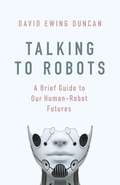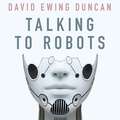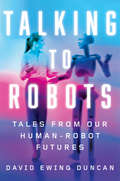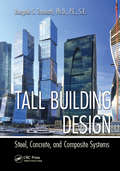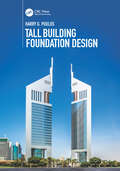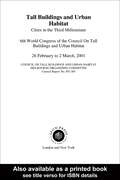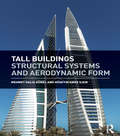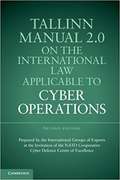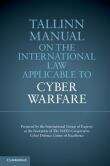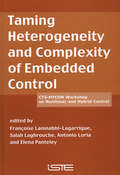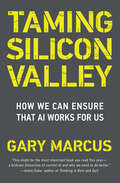- Table View
- List View
Tales from the Ant World
by Edward O. WilsonEdward O. Wilson recalls his lifetime with ants, from his first boyhood encounters in the woods of Alabama to perilous journeys into the Brazilian rainforest. “Ants are the most warlike of all animals, with colony pitted against colony,” writes E.O. Wilson, one of the world’s most beloved scientists, “their clashes dwarf Waterloo and Gettysburg.” In Tales from the Ant World, two-time Pulitzer Prize-winner Wilson takes us on a myrmecological tour to such far-flung destinations as Mozambique and New Guinea, the Gulf of Mexico’s Dauphin Island and even his parent’s overgrown backyard, thrillingly relating his nine-decade-long scientific obsession with over 15,000 ant species. Animating his scientific observations with illuminating personal stories, Wilson hones in on twenty-five ant species to explain how these genetically superior creatures talk, smell, and taste, and more significantly, how they fight to determine who is dominant. Wryly observing that “males are little more than flying sperm missiles” or that ants send their “little old ladies into battle,” Wilson eloquently relays his brushes with fire, army, and leafcutter ants, as well as more exotic species. Among them are the very rare Matabele, Africa’s fiercest warrior ants, whose female hunters can carry up to fifteen termites in their jaw (and, as Wilson reports from personal experience, have an incredibly painful stinger); Costa Rica’s Basiceros, the slowest of all ants; and New Caledonia’s Bull Ants, the most endangered of them all, which Wilson discovered in 2011 after over twenty years of presumed extinction. Richly illustrated throughout with depictions of ant species by Kristen Orr, as well as photos from Wilsons’ expeditions throughout the world, Tales from the Ant World is a fascinating, if not occasionally hair-raising, personal account by one of our greatest scientists and a necessary volume for any lover of the natural world.
Tales from the Indianapolis 500: A Collection of the Greatest Indy 500 Stories Ever Told (Tales from the Team)
by Jack Arute Jenna Fryer A. J. FoytWhat’s it like to race across the blacktop of the nation’s most famous track? How does it feel to smash into a concrete wall while going over 200 miles per hour? This exciting, humorous, and poignant collection of tales takes readers inside the most thrilling race in America. Newly updated, Tales from the Indianapolis 500 captures horrific collisions and sweet victories from drivers past and present. With the 100th race approaching, the excitement and history of the Indy 500 will be on the mind of every racing fan.Author and renowned broadcaster Jack Arute exposes readers to a fast-paced world of high-speed thrills and unbelievable wipeouts. Beginning with his first encounter at the iconic race, along with stories from racing legends like Ray Harroun, and memorable races stretching up to the present day, Arute captures an entire culture of its own. NASCAR fans, whether young or old, will revel in the chance to experience the Indy 500 from within these pages. There’s no doubt readers will feel like they’re actually there!Skyhorse Publishing, as well as our Sports Publishing imprint, is proud to publish a broad range of books for readers interested in sports-books about baseball, pro football, college football, pro and college basketball, hockey, or soccer, we have a book about your sport or your team.In addition to books on popular team sports, we also publish books for a wide variety of athletes and sports enthusiasts, including books on running, cycling, horseback riding, swimming, tennis, martial arts, golf, camping, hiking, aviation, boating, and so much more. While not every title we publish becomes a New York Times bestseller or a national bestseller, we are committed to publishing books on subjects that are sometimes overlooked by other publishers and to authors whose work might not otherwise find a home.
Tales of Discovery: Delving into the World of Biology and Medicine
by Miguel M. GarciaResearch data sharing has traditionally been addressed to other peer researchers. Nowadays there is general awareness that putting research at the disposal of society is beneficial and necessary. However, the popularization of science is a hard endeavor. It must deal with transmission of transcendental knowledge with the appealing adornment of a good story, but avoiding the risk of falling into banality. This book consists in a series of individual stories delving into the world of biology and medicine. Some topics included in this volume consist in the explanation of basic biological concepts like the origin of modern eukaryotic cells, the importance of mutations as the driving force behind evolution, the molecular ins and outs of the nervous system, or the relevance of microorganisms to humans and science including food and energy industries. Others rather lean to a more biomedical perspective and constitute popular cases that have been, to some extent, trending in global media outlets: the divulgation of some current under-reckoned non-infectious pandemics like obesity and chronic pain, the presence of longer-living populations around the world named blue zones, the American (and African) opioid crisis, or the discovery and development of CRISPR-Cas as a promising genetic editing tool. All chapters are depicted with accompanying illustrations thoroughly elaborated by professionals of Fine Arts to make it easier to understand for the non-experts… but may perhaps also proof that the scientific method and multidisciplinary work are not unique to natural sciences, but also shared by other apparently distant disciplines like arts.
Tales of Natural and Unnatural Catastrophes: A Virago Modern Classic (Virago Modern Classics #194)
by Patricia HighsmithBy the bestselling author of The Talented Mr Ripley, Carol and Strangers on a Train'Master storyteller Highsmith offers an eerily up-to-date collection of modern horror tales' Publishers WeeklyPatricia Highsmith, an American who lived most of her life in Europe, was the author of such bestselling crime novels as Strangers on a Train, and The Talented Mr. Ripley.The stories collected here are classic Highsmith - eerie, prescient and chilling, catastrophes caused by human error and dark motives. Whether evoking the White House under siege by the homeless or a 190-year-old woman perpetually near death and dimly glowing, each tale refuses to release you from its tense grip.
Tales of Tropical Plant Diseases in an Age of Climate Change: A View of Sustainability Based on Complexity Science
by Khoon ChinThis book offers a global perspective on major tropical crops, exploring their role in food production and the threats plant diseases pose to their productivity. Drawing from the author’s diverse experiences as a plant pathologist across Asia, Europe, the US, and Latin America, as well as his work as an independent research consultant on complexity science, the book offers both professional insights and personal reflections. Narratives have long been a powerful tool for human communication, often more knowledge-dense than any other form of exchange. The use of stories in this book serves three main purposes. First, complexity theory suggests that reflecting on others' stories can inspire scientists to form fresh perspectives and unique insights based on their own knowledge and experiences. This process may even help people "know what they didn’t know they knew," a concept popular in knowledge management circles. Complexity practice takes this further by helping scientists uncover what they "didn’t know they didn’t know"—a crucial element for advancing research rather than simply investigation. Second, today’s students often report learning more from the personal experiences of their teachers than from mere facts. Traditional, encyclopedic texts leave little room for the self-learning practices that are central to modern education. Stories, by contrast, are an effective way of conveying experiential or tacit knowledge, which is often more valuable in real-world contexts. Additionally, the use of narratives and visuals makes phytopathology more accessible for broader audience interested in sustainability, biodiversity, food security, biosecurity, regenerative agriculture, resilience, climate change, new technologies, and public policy. The final chapter ties the book together by focusing on sustainability and ecosystem services for the future. It also provides an extensively researched library of references on the management of tropical crop diseases, offering quick access to essential facts in the appendices.
Tales of a Dead King
by Walter Dean Myers2 teenagers uncover a plot to rob the tomb of an Egyptian pharaoh.
Talk to Me: How Voice Computing Will Transform the Way We Live, Work, and Think
by James Vlahos**To chat with the author, ask your Alexa device to "open the voice computing book."** The next great technological disruption is coming The titans of Silicon Valley are racing to build the last, best computer that the world will ever need. They know that whoever successfully creates it will revolutionize our relationship with technology—and make billions of dollars in the process. They call it conversational AI. Computers that can speak and think like humans may seem like the stuff of science fiction, but they are rapidly moving toward reality. In Talk to Me, veteran tech journalist James Vlahos meets the researchers at Amazon, Google, and Apple who are leading the way. He explores how voice tech will transform every sector of society: handing untold new powers to businesses, overturning traditional notions of privacy, upending how we access information, and fundamentally altering the way we understand human consciousness. And he even tries to understand the significance of the voice-computing revolution first-hand — by building a chatbot version of his terminally ill father. Vlahos&’s research leads him to one fundamental question: What happens when our computers become as articulate, compassionate, and creative as we are?
Talker Quality in Human and Machine Interaction: Modeling the Listener’s Perspective in Passive and Interactive Scenarios (T-Labs Series in Telecommunication Services)
by Benjamin WeissThe book discusses subjective ratings of quality and preference of unknown voices and dialog partners – their likability, for example. Human natural and artificial voices are studied in passive listening and interactive scenarios. In this book, the background, state of research, and contributions to the assessment and prediction of talker quality that is constituted in voice perception and in dialog are presented. Starting from theories and empirical findings from human interaction, major results and approaches are transferred to the domain of human-computer interaction (HCI). The main objective of this book is to contribute to the evaluation of spoken interaction in humans and between humans and computers, and in particular to the quality subsequently attributed to the speaking system or person based on the listening and interactive experience.Provides a comprehensive overview of research in evaluation of speakers and dialog partners;Presents recent results on the relevance of a first passive and interactive impression;Includes human and HCI evaluation results from a communicative perspective.
Talking Books: Pioneering and Beyond
by Marilyn Lundell MajeskaAlthough libraries had been finding ways to serve blind patrons as early as the late nineteenth century, the passage of the Pratt-Smoot Act in 1931 was a game-changer. Congress appropriated funds to provide books for blind adults, and the National Library Service for the Blind and Physically Handicapped was established. The five decades after Pratt-Smoot saw many technological developments in recording machines and techniques, some coming hand in hand with innovations in the music industry: from record players, to reel-to-reel tapes, to cassette players. Inevitably, the "talking books" program would always be a compromise between the best possible product and the limitations of what was practical and economically feasible. Author Majeska synthesizes information from interviews and old files to compile a detailed history of talking books from 1932 to 1988--before computers changed the whole scene.
Talking Health, Safety and Wellbeing: Building an Empowering Culture in a Post-COVID World
by Tim MarshThe book considers what makes an excellent face-to-face health and safety contact in the workplace, and why these contacts are a fundamental building block of any strong, caring, and empowering workplace culture. It stresses the vital importance of inquiry, empathy, and analysis in understanding what employees need to mitigate risk factors around safety and mental health. This revised and updated edition includes empowering methodologies that directly address mental health and well-being issues and the challenges organisations face in a post COVID19 era. The reader will gain an understanding of the day-to-day mechanisms of why “culture is king” and how everyone contributes every-day to this truism. This book covers how interactions regarding leadership and teamwork directly lead to the amount of human error and fallibility an organisation can expect to need to manage, and how taking proactive, analytical, and empowering approaches to safety and health is key to identifying and mitigating risks. Talking Health, Safety and Wellbeing explains why it is so important to talk about health and safety issues proactively. Written in an accessible and engaging manner, this book is an ideal read for any frontline supervisor, HR manager, mental health first aider, safety rep, or company director.
Talking Sense in Science: Helping Children Understand Through Talk
by Douglas Newton Douglas P NewtonTalking Sense in Science is a highly practical guide to getting the most out of primary science lessons through talking with children. This clearly written and straightforward book helps teachers to support understanding by developing their own interaction in the classroom. Each idea is described, illustrated and followed by a short task to develop teaching skills. This book looks at ways of understanding in science, and scientific language as well as how talk can support practical activities. Douglas Newton also addresses the ideas of what to say, when to say it and how to say it, with a view to developing understanding through science conversation. Examples given in the book span the range of primary school science topics, and provide an ideal sourcebook for lesson ideas. Talking Sense in Science is an essential buy for primary teachers who want an accessible way to improve their practice and their pupils' understanding in science. It is also an ideal learning tool for student teachers.
Talking about Life: Conversations on Astrobiology
by Chris ImpeyWith over 500 planets now known to exist beyond the Solar System, spacecraft heading for Mars, and the ongoing search for extraterrestrial intelligence, this timely book explores current ideas about the search for life in the Universe. It contains candid interviews with dozens of astronomers, geologists, biologists, and writers about the origin and range of terrestrial life and likely sites for life beyond Earth. The interviewees discuss what we've learnt from the missions to Mars and Titan, talk about the search for Earth clones, describe the surprising diversity of life on Earth, speculate about post-biological evolution, and explore what contact with intelligent aliens will mean to us. Covering topics from astronomy and planetary science to geology and biology, this book will fascinate anyone who has ever wondered 'Are we alone?'
Talking and Doing Science in the Early Years: A practical guide for ages 2-7
by Sue Dale TunnicliffeYoung children are intuitive, emergent scientists - they observe, raise hypotheses, experiment and notice patterns. Most of our everyday actions at home and in other settings, inside and outside, have a scientific basis and it is through these early experiences that children formulate their ideas about the world in which we live. This accessible book introduces the simplest form of the principles and the big ideas of science and provides a starting point for encouraging children to have an interest and experiential understanding of basic science and engineering. It shows you how you can support young children in exploring everyday phenomena and develop their scientific language skills through readily available resources and hands-on experiences. Each chapter focuses on a different aspect of science and includes: a summary of the ‘big ideas’ to refresh your own scientific knowledge; numerous activities that encourage young children to observe, question and carry out their own investigations; a usefil list of everyday resources and relevant vocabulary. Providing a wealth of exciting, meaningful ways to promote scientific experiences and learning, this highly practical book will help you to build on children’s natural curiosity about the world and develop their understanding through your everyday provision in early years settings and at home.
Talking to Robots: A Brief Guide to Our Human-Robot Futures
by David Ewing DuncanOne of Time magazine's '32 Books You Need to Read This Summer' -- 'a riveting read'.'Intensely readable, downright terrifying, and surprisingly uplifting.'Vanity Fair'A fascinating work of imaginative futurology, a science journalist takes a look at our current technologies and anticipates the human-robot future that could await us - one full of warrior bots, politician bots, doctor bots and sex bots.'One of Barbara VanDenburgh's '5 Books Not to Miss', USA TodayOne of the best summer reads of 2019, according to top authors David Baldacci and Elizabeth Acevedo on USA Today's Today programme. 'A refreshing variation on the will-intelligent-robots-bring-Armageddon genre . . . this colorful mixture of expert futurology and quirky speculation does not disappoint' Kirkus ReviewsWhat robot and AI systems are being built and imagined right now? What do they say about us, their creators? Will they usher in a fantastic new future, or destroy us? What do some of our greatest thinkers, from physicist Brian Greene and futurist Kevin Kelly to inventor Dean Kamen, geneticist George Church and filmmaker Tiffany Shlain, anticipate for our human-robot future? For even as robots and AI intrigue us and make us anxious about the future, our fascination with robots has always been about more than the potential of the technology - it also concerns what robots tell us about being human.From present-day Facebook and Amazon bots to near-future 'intimacy' bots and 'the robot that swiped my job' bots, bestselling American popular science writer David Ewing Duncan's Talking to Robots is a wonderfully entertaining and insightful guide to possible future scenarios about robots, both real and imagined.Featured bots include robot drivers; doc bots; politician bots; warrior bots; sex bots; syntheticbio bots; dystopic bots that are hopefully just bad dreams; and ultimately, God Bot (asdescribed by physicist Brian Greene). These scenarios are informed by discussions with well-known thinkers, engineers, scientists, artists, philosophers and others, who share with us their ideas, hopes and fears about robots. David spoke with, among others, Kevin Kelly, David Baldacci, Brian Greene, Dean Kamen, Craig Venter, Stephanie Mehta, David Eagleman, George Poste, George Church, General R. H. Latiff, Robert Seigel, Emily Morse, David Sinclair, Ken Goldberg, Sunny Bates, Adam Gazzaley, Tim O'Reilly, Tiffany Shlain, Eric Topol and Juan Enriquez.These discussions, along with some reporting on bot-tech, bot-history and real-time societal andethical issues with robots, are the launch pads for unfurling possible bot futures that are informed by how people and societies have handled new technologies in the past.The book describes how robots work, but its primary focus is on what our fixation with botsand AI says about us as humans: about our hopes and anxieties; our myths, stories, beliefs andideas about beings both real and artificial; and our attempts to attain perfection.We are at a pivotal moment when our ancient infatuation with human-like beings with certainattributes or superpowers - in mythology, religion and storytelling - is coinciding with ourability to actually build some of these entities.
Talking to Robots: A Brief Guide to Our Human-Robot Futures
by David Ewing DuncanOne of Time magazine's '32 Books You Need to Read This Summer' -- 'a riveting read'.'Intensely readable, downright terrifying, and surprisingly uplifting.'Vanity Fair 'A fascinating work of imaginative futurology, a science journalist takes a look at our current technologies and anticipates the human-robot future that could await us - one full of warrior bots, politician bots, doctor bots and sex bots.'One of Barbara VanDenburgh's '5 Books Not to Miss', USA Today One of the best summer reads of 2019, according to top authors David Baldacci and Elizabeth Acevedo on USA Today's Today programme. 'A refreshing variation on the will-intelligent-robots-bring-Armageddon genre . . . this colorful mixture of expert futurology and quirky speculation does not disappoint' Kirkus ReviewsWhat robot and AI systems are being built and imagined right now? What do they say about us, their creators? Will they usher in a fantastic new future, or destroy us? What do some of our greatest thinkers, from physicist Brian Greene and futurist Kevin Kelly to inventor Dean Kamen, geneticist George Church and filmmaker Tiffany Shlain, anticipate for our human-robot future? For even as robots and AI intrigue us and make us anxious about the future, our fascination with robots has always been about more than the potential of the technology - it also concerns what robots tell us about being human.From present-day Facebook and Amazon bots to near-future 'intimacy' bots and 'the robot that swiped my job' bots, bestselling American popular science writer David Ewing Duncan's Talking to Robots is a wonderfully entertaining and insightful guide to possible future scenarios about robots, both real and imagined.Featured bots include robot drivers; doc bots; politician bots; warrior bots; sex bots; syntheticbio bots; dystopic bots that are hopefully just bad dreams; and ultimately, God Bot (asdescribed by physicist Brian Greene). These scenarios are informed by discussions with well-known thinkers, engineers, scientists, artists, philosophers and others, who share with us their ideas, hopes and fears about robots. David spoke with, among others, Kevin Kelly, David Baldacci, Brian Greene, Dean Kamen, Craig Venter, Stephanie Mehta, David Eagleman, George Poste, George Church, General R. H. Latiff, Robert Seigel, Emily Morse, David Sinclair, Ken Goldberg, Sunny Bates, Adam Gazzaley, Tim O'Reilly, Tiffany Shlain, Eric Topol and Juan Enriquez.These discussions, along with some reporting on bot-tech, bot-history and real-time societal andethical issues with robots, are the launch pads for unfurling possible bot futures that are informed by how people and societies have handled new technologies in the past.The book describes how robots work, but its primary focus is on what our fixation with botsand AI says about us as humans: about our hopes and anxieties; our myths, stories, beliefs andideas about beings both real and artificial; and our attempts to attain perfection.We are at a pivotal moment when our ancient infatuation with human-like beings with certainattributes or superpowers - in mythology, religion and storytelling - is coinciding with ourability to actually build some of these entities.
Talking to Robots: Tales from Our Human-Robot Futures
by David Ewing DuncanAward-winning journalist David Ewing Duncan considers 24 visions of possible human-robot futures—Incredible scenarios from Teddy Bots to Warrior Bots, and Politician Bots to Sex Bots—Grounded in real technologies and possibilities and inspired by our imagination. What robot and AI systems are being built and imagined right now? What do they say about us, their creators? Will they usher in a fantastic new future, or destroy us? What do some of our greatest thinkers, from physicist Brian Greene and futurist Kevin Kelly to inventor Dean Kamen, geneticist George Church, and filmmaker Tiffany Shlain, anticipate about our human-robot future? For even as robots and A.I. intrigue us and make us anxious about the future, our fascination with robots has always been about more than the potential of the technology–it’s also about what robots tell us about being human.
Tall Building Design: Steel, Concrete, and Composite Systems
by Bungale S. TaranathAddresses the Question Frequently Proposed to the Designer by Architects: "Can We Do This? Offering guidance on how to use code-based procedures while at the same time providing an understanding of why provisions are necessary, Tall Building Design: Steel, Concrete, and Composite Systems methodically explores the structural behavior of steel, concrete, and composite members and systems. This text establishes the notion that design is a creative process, and not just an execution of framing proposals. It cultivates imaginative approaches by presenting examples specifically related to essential building codes and standards. Tying together precision and accuracy—it also bridges the gap between two design approaches—one based on initiative skill and the other based on computer skill. The book explains loads and load combinations typically used in building design, explores methods for determining design wind loads using the provisions of ASCE 7-10, and examines wind tunnel procedures. It defines conceptual seismic design, as the avoidance or minimization of problems created by the effects of seismic excitation. It introduces the concept of performance-based design (PBD). It also addresses serviceability considerations, prediction of tall building motions, damping devices, seismic isolation, blast-resistant design, and progressive collapse. The final chapters explain gravity and lateral systems for steel, concrete, and composite buildings. The Book Also Considers: Preliminary analysis and design techniques The structural rehabilitation of seismically vulnerable steel and concrete buildings Design differences between code-sponsored approaches The concept of ductility trade-off for strength Tall Building Design: Steel, Concrete, and Composite Systems is a structural design guide and reference for practicing engineers and educators, as well as recent graduates entering the structural engineering profession. This text examines all major concrete, steel, and composite building systems, and uses the most up-to-date building codes.
Tall Building Foundation Design
by Harry G. PoulosThis book provides a comprehensive guide to the design of foundations for tall buildings. After a general review of the characteristics of tall buildings, various foundation options are discussed followed by the general principles of foundation design as applied to tall buildings. Considerable attention is paid to the methods of assessment of the geotechnical design parameters, as this is a critical component of the design process. A detailed treatment is then given to foundation design for various conditions, including ultimate stability, serviceability, ground movements, dynamic loadings and seismic loadings. Basement wall design is also addressed. The last part of the book deals with pile load testing and foundation performance measurement, and finally, the description of a number of case histories. A feature of the book is the emphasis it places on the various stages of foundation design: preliminary, detailed and final, and the presentation of a number of relevant methods of design associated with each stage.
Tall Buildings and Urban Habitat
by Lynn BeadleThis book, the result of the Council on Tall Buildings and Urban Habitat 6th World Congress: Cities in the Third Millennium, examines the issues which must be addressed if we are to have a common understanding of the forces of change.Experts in architecture, engineering and planning contribute a commentary on the existing condition of urban design,
Tall Buildings: Structural Systems and Aerodynamic Form
by Mehmet Halis Günel Hüseyin Emre IlginThe structural challenges of building 800 metres into the sky are substantial, and include several factors which do not affect low-rise construction. This book focusses on these areas specifically to provide the architectural and structural knowledge which must be taken into account in order to design tall buildings successfully. In presenting examples of steel, reinforced concrete, and composite structural systems for such buildings, it is shown that wind load has a very important effect on the architectural and structural design. The aerodynamic approach to tall buildings is considered in this context, as is earthquake induced lateral loading. Case studies of some of the world’s most iconic buildings, illustrated with full colour photographs, structural plans and axonometrics, will bring to life the design challenges which they presented to architects and structural engineers. The Empire State Building, the Burj Khalifa, Taipei 101 and the HSB Turning Torso are just a few examples of the buildings whose real-life specifications are used to explain and illustrate core design principles, and their subsequent effect on the finished structure.
Tallgrass Prairie Restoration in the Midwestern and Eastern United States
by Harold GardnerThis work advocates the restoration of the North American tallgrass prairie, which is rapidly disappearing. Historical descriptions of prairie aesthetics are outlined. As we are experiencing a worldwide mixing of plant species, prairie restoration is particularly important. Plants alien to North America do not readily support insect populations, including all animal species higher on the food chain. Prairie restoration methods are described for amateurs, academics, and land managers. Some of the techniques described are growing crops for seed production, times of seed gathering for specific species, facile seed processing for amateurs, land preparation, segregation of seed into its preference for habitat, and required seed treatment for germination. Over 200 species are described that comprise the predominant species found in tallgrass prairie nature preserves, as well as degraded prairies. Some additional plants of especial interest are also described. The appendix tabulates all likely species found on prairies regardless of their scarcity. Safe fire management of prairies is described in detail. Finally, methods of controlling aggressive alien weeds by herbicides are detailed.
Tallinn Manual 2.0 on the International Law Applicable to Cyber Operations
by Schmitt Michael N.Tallinn Manual 2. 0 expands on the highly influential first edition by extending its coverage of the international law governing cyber operations to peacetime legal regimes. The product of a three-year follow-on project by a new group of twenty renowned international law experts, it addresses such topics as sovereignty, state responsibility, human rights, and the law of air, space, and the sea. Tallinn Manual 2. 0 identifies 154 'black letter' rules governing cyber operations and provides extensive commentary on each rule. Although Tallinn Manual 2. 0 represents the views of the experts in their personal capacity, the project benefitted from the unofficial input of many states and over fifty peer reviewers.
Tallinn Manual on the International Law Applicable to Cyber Warfare
by Michael N. SchmittThe product of a three-year project by twenty renowned international law scholars and practitioners, the Tallinn Manual identifies the international law applicable to cyber warfare and sets out ninety-five 'black-letter rules' governing such conflicts. It addresses topics including sovereignty, State responsibility, the jus ad bellum, international humanitarian law, and the law of neutrality. An extensive commentary accompanies each rule, which sets forth the rule's basis in treaty and customary law, explains how the group of experts interpreted applicable norms in the cyber context, and outlines any disagreements within the group as to each rule's application.
Taming Heterogeneity and Complexity of Embedded Control
by Elena Panteley Antonio Loria Salah Laghrouche Françoise Lamnabhi-LagarrigueThis book gathers together a selection of papers presented at the Joint CTS-HYCON Workshop on Nonlinear and Hybrid Control held at the Paris Sorbonne, France, 10-12 July 2006. The main objective of the Workshop was to promote the exchange of ideas and experiences and reinforce scientific contacts in the large multidisciplinary area of the control of nonlinear and hybrid systems.
Taming Silicon Valley: How We Can Ensure That AI Works for Us
by Gary F. MarcusHow Big Tech is taking advantage of us, how AI is making it worse, and how we can create a thriving, AI-positive world.On balance, will AI help humanity or harm it? AI could revolutionize science, medicine, and technology, and deliver us a world of abundance and better health. Or it could be a disaster, leading to the downfall of democracy, or even our extinction. In Taming Silicon Valley, Gary Marcus, one of the most trusted voices in AI, explains that we still have a choice. And that the decisions we make now about AI will shape our next century. In this short but powerful manifesto, Marcus explains how Big Tech is taking advantage of us, how AI could make things much worse, and, most importantly, what we can do to safeguard our democracy, our society, and our future.Marcus explains the potential—and potential risks—of AI in the clearest possible terms and how Big Tech has effectively captured policymakers. He begins by laying out what is lacking in current AI, what the greatest risks of AI are, and how Big Tech has been playing both the public and the government, before digging into why the US government has thus far been ineffective at reining in Big Tech. He then offers real tools for readers, including eight suggestions for what a coherent AI policy should look like—from data rights to layered AI oversight to meaningful tax reform—and closes with how ordinary citizens can push for what is so desperately needed.Taming Silicon Valley is both a primer on how AI has gotten to its problematic present state and a book of activism in the tradition of Abbie Hoffman&’s Steal This Book and Thomas Paine&’s Common Sense. It is a deeply important book for our perilous historical moment that every concerned citizen must read.
